
Alternative Process Tutorial #4
Coating Paper
Rod Coating Page: Part C
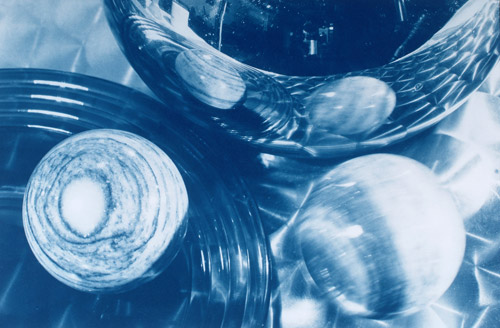
Illustration #35: Cyanotype Photograph
Copyright © 2001 by Tom Ferguson
Click on image for larger view

Illustration #36: Palladium on Canvas
Copyright © 2001 by Tom Ferguson
Click on image for larger view
Rod Coating Technique: For rod coating, your paper must have a smooth or "hot pressed" surface. The image in illustration #36, printed on painter's canvas, could not be coated with a rod. Rods can be purchased from Bostick and Sullivan (they call them "Puddle Pushers"). They can also be made from glass tubing or acrylic rods (see illustration #37).
Next, check your paper for "watermarks" by holding it up to a bright light, so that you are looking through it. Many papers have a front and back side, and these papers usually print best on the front side. If you see a watermark, you are looking at the front of the paper if the writing is correct, and the back of the paper if the writing is backwards. If you are working from a paper "pad", then they are placed in the pad front side up. Cut or tear your chosen paper to a size 5 inches (100mm) larger than your negative. If you have a 4x5 inch neg, make your paper 9x10 inches. On the front and in the center of the paper mark a top and bottom line 1 inch (25mm) longer than the long dimension of your film. For example, with 4x5 film, mark two lines 6 inches (150m) apart (5 inches of film + 1 inch spare = 6 inches) (see illustration #38). You will need to coat at least two sheets of paper for each negative you intend to print.
You will need about 0.6ml of solution for each 4x5 print or 2ml for each 8x10 print. Determine the number of sheets you plan on coating and multiply to get the amount of solution you need. The coating solution is mixed by putting 3 parts of "cyanotype A" for every 2 parts of "cyanotype B" together and mixing them. This is called a 1.5 to 1 ratio. For example, assume we want to coat 10 sheets of paper for 4x5 negatives. This requires 0.6ml of coating solution per neg, so we multiply the number of prints times the solution needed per print (10 x 0.6ml = 6ml). It is best to have a little 2ml to your equation. Our total volume needed is now 18ml (10 prints x 0.6ml + 2 ml spare = 8ml).
Mix the solution and coat the paper in subdued tungsten (common light bulb) lighting. Do not work in a room with sunlight or fluorescent lighting. See tutorial #3 for more information on working light levels.
Turn on your room's ventilation and put on your safety gloves (see tutorial 3). "Cyanotype A" makes up 3 of 5 parts in our formula. Multiply the total volume by 3/5 (8ml X 0.6 = 4.8ml). Measure 4.8ml of "Cyanotype A" with your 10ml graduate, then pur into your mixing beaker. "Cyanotype B" makes up the remaining 2 of 5 parts in our formula. Multiply the total volume by 2/5 (8ml X 0.4 = 3.2ml). Measure 3.2ml of "Cyanotype A" with your 10ml graduate, then pour it into your mixing beaker with the "A". Give the mixture in the beaker a quick stir. Kept in their separate bottles, Cyanotype A will not spoil for many months and Cyanotype B will not spoil for many years. Once mixed together, the coating solution should be used within a few hours.
Note that most texts recommend mixing the solutions "A" and "B" in equal amounts (4ml of each in our example above). While this does make the math easier, I find the 3:2 formula above gives better images.
Pour the amount of coating solution needed (0.6ml for 4x5 negs, 2ml for 8x10 negs) into your smaller 10ml graduate. Place a sheet of glass (with safety edges) onto a level work area. This glass should be at least 9 inches (225mm) larger than your negative (at least 4 inches larger than your paper). The glass is to provide a perfectly even surface. Place a few sheets of newsprint (unprinted newspaper, available at most box and moving supply stores) down over the glass. The paper adds a small amount of "cushion" to the workspace. Then put your paper with the pencil marks onto the center of the glass and newspaper.
Pour the coating solution out of the graduate and onto the paper in a line or "bead" on top of either of the pencil lines. Once you have poured the coating solution onto the paper, you need to work and finish quickly, or your paper may be "splotchy". Place the coating rod behind the bead of solution (between the solution and the edge of the paper). Now bring the rod forward until it touches the bead of solution. Wiggle the rod up and down, perhaps 1/4 inch (6mm), in the same direction as the bead (see illustration #39). This distributes the solution equally along the rod. Next, using a moderate amount of pressure, push the rod across the paper to the opposite pencil line (see illustration #40). Lift the rod completely off of the paper and place it behind the bead of solution (between the solution and the edge of the paper (see illustration #42). Finally, push the rod back across the paper to the pencil mark you started on (see illustration #43).
Many papers will require you to continue pushing the rod a few more cycles . Stop when the paper is evenly covered, added pushing only risks damaging the surface of the wet paper. My suggested volume of solution per image is for papers of average absorbency. Soft papers (absorbent papers) will need more solution , hard papers (well sized papers) will need less. Even your relative humidity can alter this. So, don't be afraid to use more if you can't get an even coat, or less if you always have a puddle left over.
Put the paper in a totally dark space and let it air dry. You should not use heat in drying the paper, it can fog the papers highlights and change its contrast. Heat will also put more fumes into the air for you to breath. Once the paper is completely dry, you are ready for tutorial #6 (where you finally get to make a print!). Do not try and use an "almost dry" sheet of paper, as this can damage your negative.
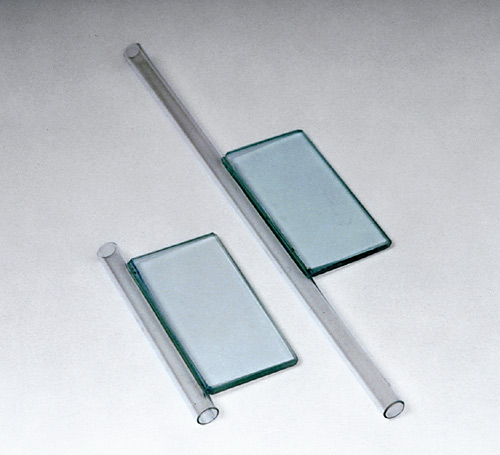
Illustration #37: Coating rods
Copyright © 2001 by Tom Ferguson
Click on image for larger view
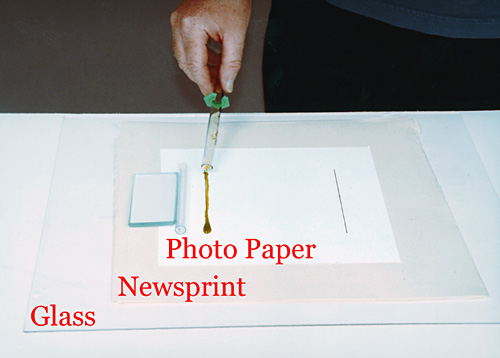
Illustration #38: Setting up
Copyright © 2001 by Tom Ferguson
Click on image for larger view
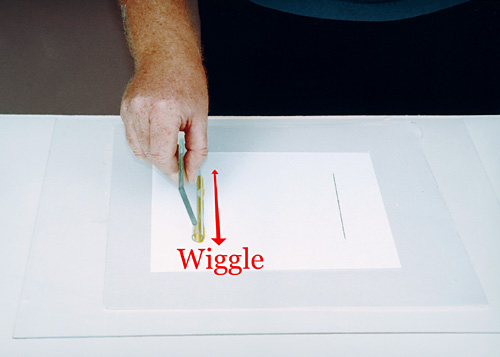
Illustration #39: Wiggle rod
Copyright © 2001 by Tom Ferguson
Click on image for larger view
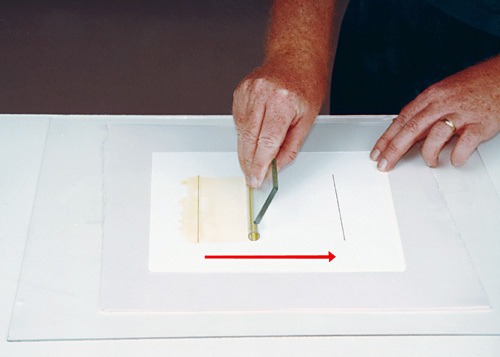
Illustration #40: Starting to coat
Copyright © 2001 by Tom Ferguson
Click on image for larger view
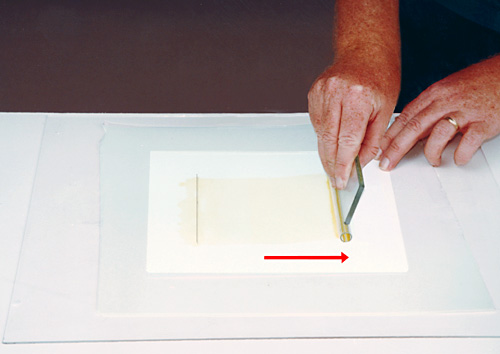
Illustration #41: End of first pass
Copyright © 2001 by Tom Ferguson
Click on image for larger view
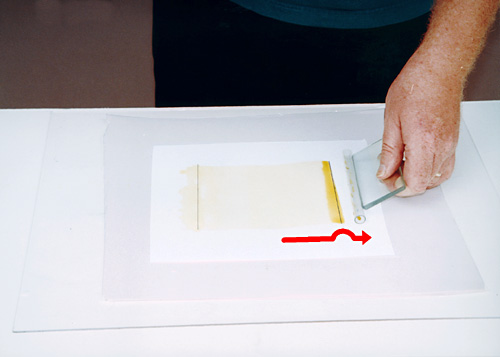
Illustration #42: Jump rod behind puddle line
Copyright © 2001 by Tom Ferguson
Click on image for larger view
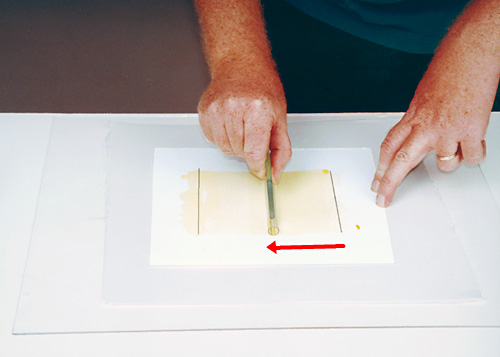
Illustration #43: Push rod in opposite direction
Copyright © 2001 by Tom Ferguson
Click on image for larger view
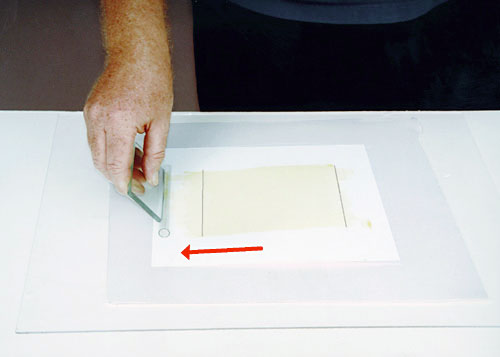
Illustration #44: Finished
Copyright © 2001 by Tom Ferguson
Click on image for larger view
Click here to view the Brush Coating Page
Click the "next" link below and I'll describe how to expose and develop your first cyanotype print.